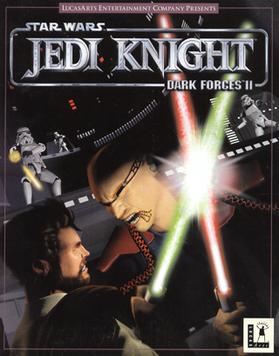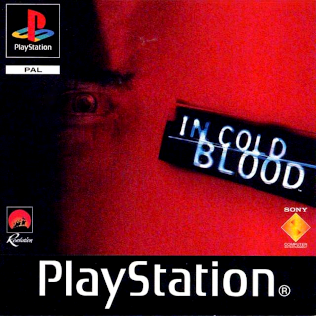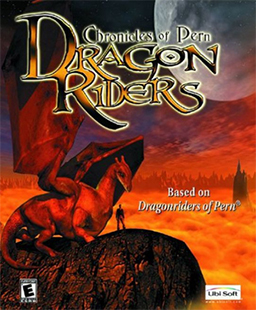
Star Wars Jedi Knight: Dark Forces II is a 1997 first-person shooter video game developed and published by LucasArts for Microsoft Windows. It is the sequel to 1995's Star Wars: Dark Forces, and the second installment in the Star Wars: Jedi Knight series. The story, set in the fictional Star Wars expanded universe one year after the film Return of the Jedi, follows returning protagonist Kyle Katarn, a mercenary working for the New Republic, who discovers his connection to the Force and "The Valley of the Jedi", an ancient source of power. With his father having been murdered years prior by the Dark Jedi Jerec and his followers over the Valley's location, Katarn embarks on a quest to confront his father's killers and find the Valley before they do.

Escape from Monkey Island is an adventure game developed and released by LucasArts in 2000. It is the fourth game in the Monkey Island series, and the sequel to the 1997 videogame The Curse of Monkey Island. It is the first game in the series to use 3D graphics and the second game to use the GrimE engine, which was upgraded from its first use in Grim Fandango.

Fallout 2: A Post Nuclear Role Playing Game is a 1998 role-playing video game developed by Black Isle Studios and published by Interplay Productions. It is a sequel to Fallout (1997), featuring similar graphics and game mechanics. The game's story takes place in 2241, 80 years after the events of Fallout and 164 years after the atomic war which reduced the vast majority of the world to a nuclear wasteland. The player assumes the role of The Chosen One, the grandchild of the first game's protagonist, and undertakes a quest to save their small village on the West Coast of the United States.

The Elder Scrolls III: Bloodmoon is the second and final expansion pack for The Elder Scrolls III: Morrowind, developed by Bethesda Game Studios. It was originally released as an expansion set for Microsoft Windows and is included within the Morrowind: Game of the Year edition for Xbox.

Painkiller is a first-person shooter video game developed by Polish game studio People Can Fly and published by DreamCatcher Interactive in April 2004 for Microsoft Windows and ported to Xbox in 2006. The game's single player campaign follows a dead man in Purgatory who is offered a deal to defeat the invading forces of Lucifer's army in exchange for being allowed to enter Heaven. The game was particularly well-received for its multiplayer experience and was featured for two seasons on the Cyberathlete Professional League's World Tour.

Paperboy is an arcade action game developed and published by Atari Games and Midway Games, and released in 1985. The player takes the role of a paperboy who delivers a fictional newspaper called The Daily Sun along a suburban street on his bicycle. The arcade version of the game featured bike handlebars as the controller.

Wetrix is a 3D puzzle video game developed by Zed Two, the studio of brothers Ste and John Pickford, for the Nintendo 64 and personal computers in 1998, and the Dreamcast and Game Boy Color in 1999. The player's goal is to hold water bubbles falling on a 3D isometric landscape. To do this, enclosures are created with Uppers, which fall in a similar manner to Tetris blocks, that raise the ground. While water can be evaporated with fireballs, hazards such as Mines, Ice Cubes, and earthquakes also fall and ruin the player's construction.

In Cold Blood is an adventure game developed by Revolution Software for the PlayStation and Microsoft Windows in 2000 in Europe and in 2001 in North America. The player assumes the role of John Cord—an MI6 agent who is captured while on assignment and tries to figure out who betrayed him through a series of flashbacks.

Harry Potter and the Philosopher's Stone is an action-adventure video game based on the 2001 film of the same name. Philosopher's Stone was initially released for Microsoft Windows and the PlayStation in November 2001. A different game bearing the same name was made two years later for the GameCube, PlayStation 2, and Xbox in December 2003. The versions on different platforms differ greatly from each other and do not follow the same level structures or gameplay, with somewhat varying stories as well.

TimeShift is a first-person shooter developed by Saber Interactive and published by Vivendi Games for Microsoft Windows, Xbox 360, and PlayStation 3 in late 2007. It was developed using the Saber3D Engine.

Zeus: Master of Olympus is a single-player strategy game developed by Impressions Games and published by Sierra Studios. It is considered to be an additional installment in the City Building series of games. Like previous titles in the series, Zeus focuses on the building and development of a city in ancient times. The game features a number of changes from previous titles in the series, including being set in Ancient Greece as well as changes to certain gameplay mechanics; however, it is considered to be in most aspects very similar to its predecessor, Caesar III.

Ring: The Legend of the Nibelungen is a 1998 point-and-click adventure video game for Microsoft Windows and Mac OS developed by Arxel Tribe and published in North America by Red Orb Entertainment and in Europe by Cryo Interactive. The game is based on Richard Wagner's four opera cycle Der Ring des Nibelungen, and features music from various performances of the Vienna Philharmonic Orchestra conducted by Georg Solti from 1958 to 1964, chosen in collaboration with PolyGram and Decca. French comic-book artist Philippe Druillet also worked on the game, providing much of the artwork.

Europa 1400: The Guild is a 2002 simulation game developed by 4HEAD Studios and published by JoWooD Productions. It is the first installment in the Guild series, released on 25 October 2002, for Microsoft Windows. The game simulates medieval life combined with elements of real-time strategy, role-playing, and nonlinear gameplay using a 3D engine. Taking place in historic European cities, the player tries to guide a family dynasty to power and wealth, starting from one character of limited means. Players can choose from a total of a dozen professions.

Atlantis III: The New World,, is a 2001 fantasy adventure video game developed and published by Cryo Interactive, with Dreamcatcher Interactive publishing the game in North America. David Rhodes composed the musical score. It is the third game in the Atlantis series by Cryo, as well as the last one made before Cryo's closure. It was followed by Atlantis Evolution in 2004.

Dragonriders: Chronicles of Pern is an adventure game published by Ubi Soft in 2001.
Crysis is a first-person shooter video game series created by Crytek. The series revolves around a group of military protagonists with "nanosuits", technologically advanced suits of armor that give them enhanced physical strength, speed, defense, and cloaking abilities. The protagonists face off against hostile North Korean soldiers, heavily armed mercenaries, and a race of technologically advanced aliens known as the Ceph, who arrived on Earth millions of years ago and have recently been awakened. The series consists of three main installments, a standalone spinoff of the first game with a separate multiplayer title, and a compilation. A fourth game, under the working title of Crysis 4, was announced by Crytek on January 26, 2022.

The Walking Dead is an episodic graphic adventure game series developed and published by Telltale Games and Skybound Games. It is based on the comic book series of the same name by Robert Kirkman, Tony Moore, and Charlie Adler. First released in April 2012, the series currently spans four main five-episode seasons, an additional episode as downloadable content, and a mini three-episode season, with the fourth and final season being released in 2018 and ended in 2019. The games have been released to personal computers, game consoles, and mobile devices and have had both digital and physical releases.

Timeline is a 2000 adventure/puzzle video game published by Eidos Interactive for the Microsoft Windows. The game was developed by author Michael Crichton's Timeline Computer Entertainment, and is based on Crichton's 1999 novel of the same name. Crichton was directly involved in the game's creation.

3-D Ultra Pinball: Thrillride is a 2000 pinball game developed for Windows and Macintosh by Dynamix Inc. and for the Game Boy Color by Left Field Productions, and published by Sierra On-Line. The game is part of the 3-D Ultra Pinball series of pinball games.

Grom: Terror in Tibet is an action-adventure video game by Polish developer Rebelmind and published by CDV Software Entertainment in Germany in 2002 and worldwide in 2003. Described as an "action role-playing game", the game involves the control of a party of three characters to defeat Nazis in a fictionalised Second World War, seeking the source of mythical weapons in Tibet. The developers designed the game to imitate the tone and narrative of Indiana Jones, stating a desire to return to a "mysterious charm of old adventure games", placing a heavier focus on narrative development and adventure game elements compared to other action games in the genre. Terror in Tibet received a mixed reception from critics, with the game receiving praise for its unique blend of genres, and criticism for its difficult combat and controls, and poor localisation and dialogue.



















